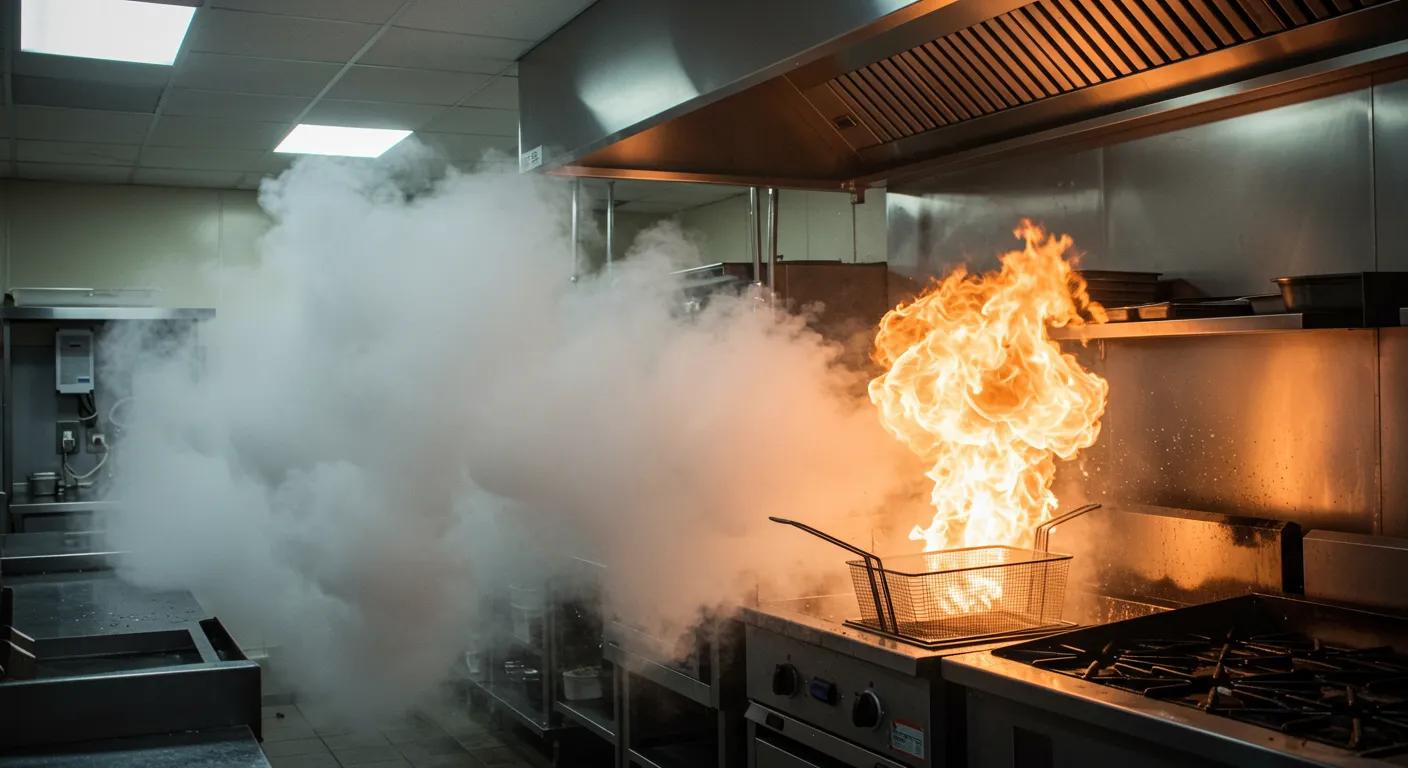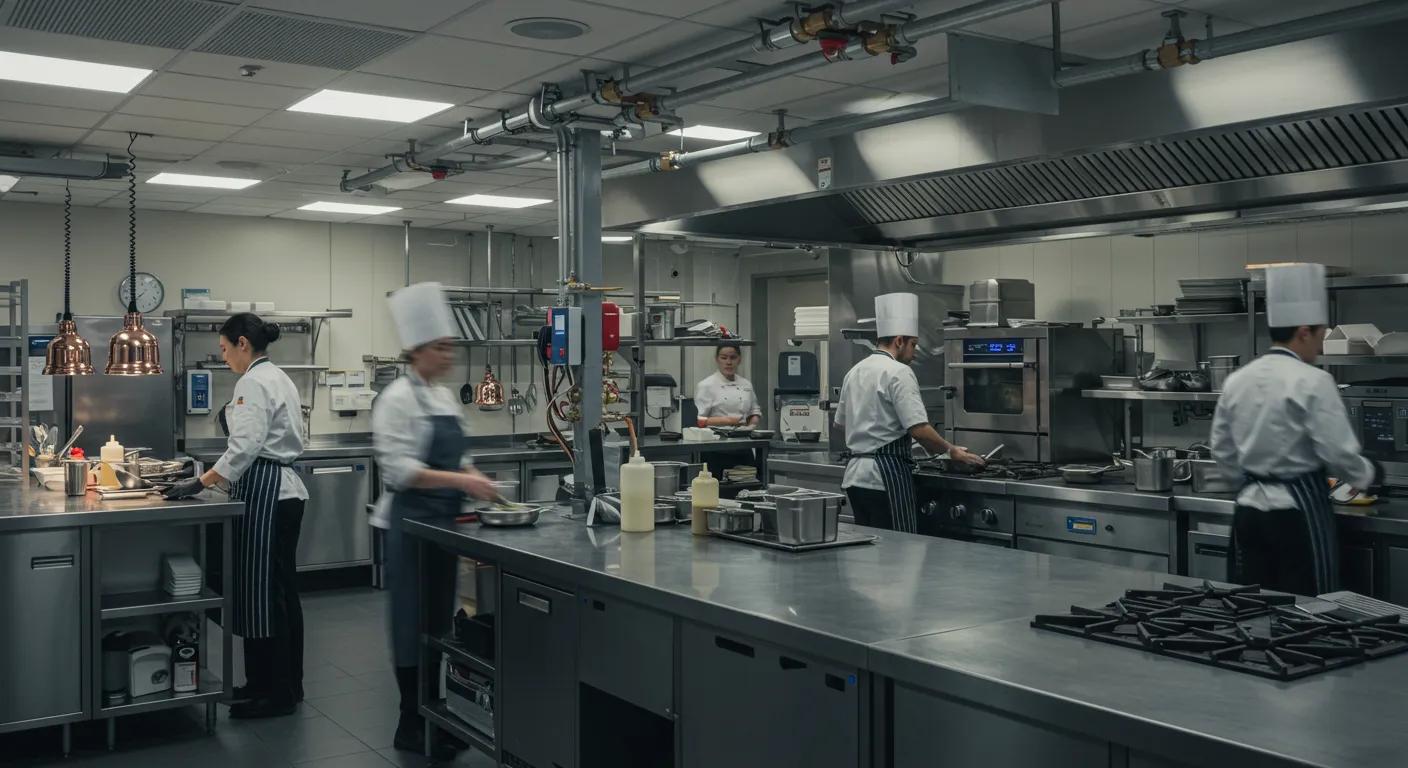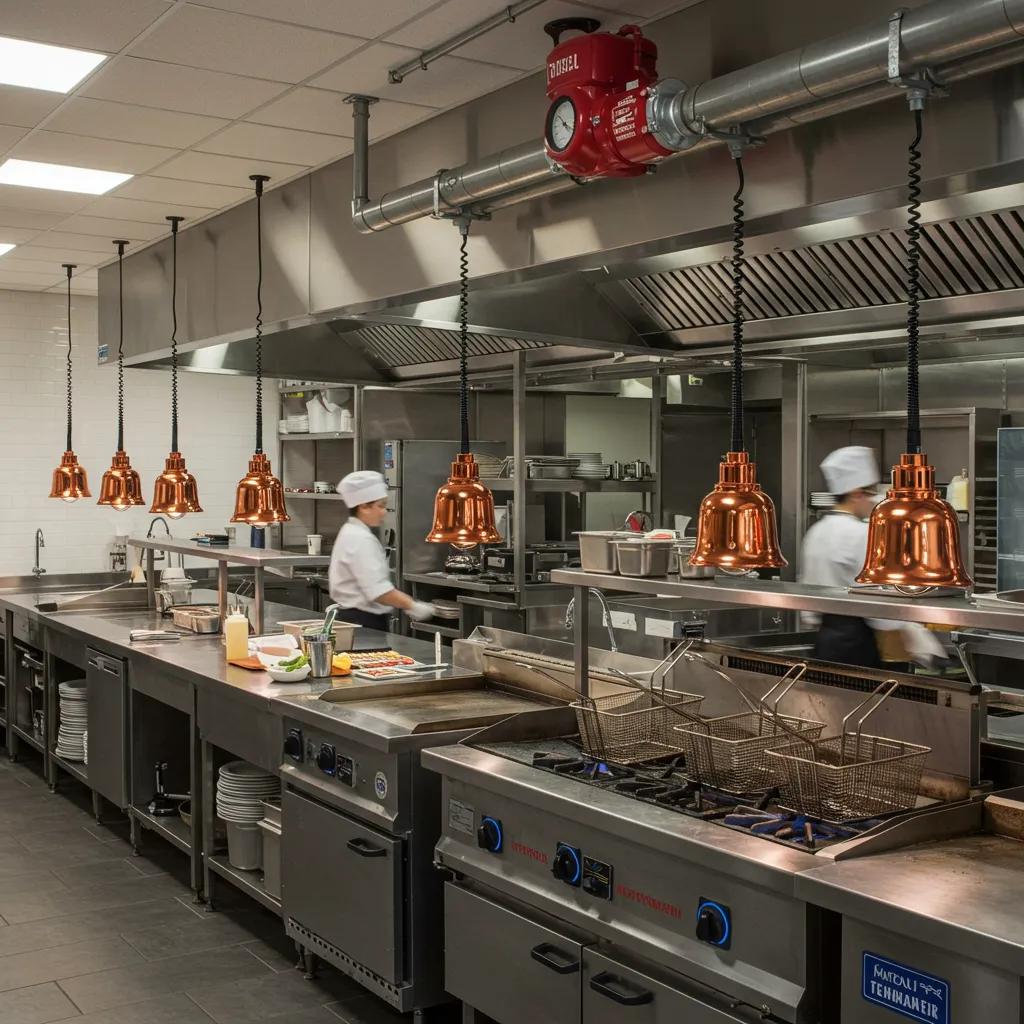Your Guide to Choosing the Right Commercial Kitchen Fire Suppression System with Armor Fire Protection
Selecting the ideal commercial kitchen fire suppression system is critical, starting with a clear understanding of the unique hazards: grease-laden fires from cooking equipment demand swift detection, precise agent application, and robust hood and duct protection. This comprehensive guide will walk you through system types, essential regulatory requirements like NFPA 96, key selection factors (equipment, layout, budget, maintenance), and what to expect throughout installation and ongoing service. Our aim is to empower restaurateurs and food-service operators to confidently evaluate wet chemical and hybrid systems, compare leading brands, and secure a fully compliant solution tailored to local Arizona Authority Having Jurisdiction (AHJ) requirements. You’ll gain insight into how these systems combat Class K grease fires, how local codes shape design and permitting, and how consistent maintenance minimizes both downtime and liability. Beyond the technical details, we’ll also show how a trusted local provider can expertly manage design, permitting, installation, testing, and crucial semi-annual inspections to keep your kitchen safe, compliant, and running smoothly.
Understanding Your Options: Main Types of Commercial Kitchen Fire Suppression Systems
Commercial kitchen fire suppression systems are expertly engineered to swiftly detect and control cooking fires. They achieve this through precise agent discharge, seamless hood and duct integration, and strategic nozzle coverage. These systems effectively extinguish grease fires, rapidly cool hot surfaces, and prevent reflash using either specialized chemical reactions or combined agent strategies. Your choice of system will hinge on your specific equipment, cooking volume, and the overall coverage area required. To help you quickly grasp the key differences, we’ve provided a concise comparison of major system characteristics below, before diving into more detailed descriptions.
This concise comparison clearly illustrates why wet chemical and hybrid systems are the predominant choice for commercial kitchen applications. It also prepares you for the deeper technical insights into their mechanisms and ideal use cases that follow. The next sections will detail how both wet chemical and hybrid systems function, helping you understand which approach best suits your specific operational needs.
The Science of Safety: How Wet Chemical Systems Combat Grease Fires

Wet chemical systems offer robust protection against grease fires, primarily through a powerful combination of saponification, rapid cooling, and smothering actions, all delivered by a specialized potassium-based agent. Upon discharge onto burning grease, this wet chemical instantly reacts with the oils, creating a soapy layer that effectively isolates the fuel from oxygen. This process also dramatically lowers the surface temperature, significantly reducing the risk of reflash and limiting heat transfer to adjacent equipment. These systems seamlessly integrate with your kitchen’s hood and duct detection, precisely targeting nozzles over specific appliances. This makes them the National Fire Protection Association (NFPA)-recommended solution for Class K hazards in commercial cooking environments. To maintain peak performance and code compliance, regular service is essential, including semi-annual professional inspections, visual checks of agent containers and nozzles, and mandatory agent recharge or replacement following any activation.
Unlocking Advanced Protection: The Benefits of Hybrid Fire Suppression Systems (e.g., Piranha®)

Hybrid systems represent a significant leap in fire suppression technology, combining powerful wet chemical agents with innovative design features engineered for even faster knockdown and superior cooling. This makes them exceptionally well-suited for high-volume or high-BTU cooking lines that might overwhelm a standard wet chemical system. The hybrid approach achieves quicker flame knockdown by integrating advanced discharge patterns or supplementary components, specifically designed to combat intense heat and mitigate the risk of reflash. This enhanced performance is particularly beneficial for operations featuring deep fryers, woks, or complex mixed-equipment lines.
Maintaining hybrid systems involves the same rigorous semi-annual inspections mandated by NFPA 96, alongside meticulous attention to any proprietary components that require scheduled servicing or replacement to ensure optimal performance.
While selecting a hybrid system often involves a slightly higher initial complexity, it delivers potentially superior performance under the most extreme cooking conditions. This is precisely why your specific equipment type and cooking volume should be the primary drivers in your system selection.
Now that we’ve explored system mechanics and their respective trade-offs, let’s delve into how crucial regulatory requirements will shape the design and ongoing inspection expectations for any system you ultimately choose.
Navigating Compliance: NFPA 96 and Arizona’s Local Regulations for Your Fire Suppression System
NFPA 96 sets the foundational minimum fire safety requirements for the design, installation, operation, inspection, and maintenance of all commercial cooking operations. These critical standards directly impact your system selection, hood construction, and the frequency of required inspections. Key NFPA 96 elements influencing your suppression choice include specific hood and duct configurations, stringent listing standards for suppression systems protecting cooking equipment, mandatory semi-annual inspection requirements, and precise procedures for testing and certification following installation or discharge. Since NFPA 96 serves as the essential baseline, your chosen system must be listed for the specific appliances it protects and installed with nozzles and detectors precisely meeting the coverage and activation requirements outlined in the standard. The following section will detail the most commonly cited NFPA 96 compliance points, helping you ensure readiness well before design or permitting begins.
Essential Compliance: Key NFPA 96 Requirements for Commercial Kitchen Fire Safety
NFPA 96 mandates several critical measures for ongoing fire safety: routine hood and duct cleaning, rigorous suppression system listing and testing, and thoroughly documented semi-annual inspections. These are all designed to prevent dangerous grease accumulation and system degradation that could elevate fire risk. Detection and actuation mechanisms must be precisely positioned to activate before flame spread, while nozzles are required to deliver complete, unobstructed coverage of all cooking appliances for effective agent application. The standard further outlines specific procedures for testing after initial installation and following any system discharge, including necessary recharging, component replacement, and formal documentation to maintain a comprehensive, compliant service history. As an operator, maintaining meticulous records of all cleaning, tests, and inspections is crucial for demonstrating ongoing compliance and supporting both insurance and permitting requirements.
Local Impact: How Arizona Fire Codes and the AHJ Influence Your Installation
Beyond NFPA 96, local Arizona fire codes and the Authority Having Jurisdiction (AHJ) often introduce additional permit requirements, specific plan submittals, or unique installation details. It’s crucial to remember that these local requirements can vary significantly across the Phoenix metro area, including cities like Tempe, Chandler, Mesa, and Scottsdale. The practical impacts of AHJ involvement include specific documentation requests during plan review, mandatory on-site inspections to verify nozzle placement and hood clearances, and municipality-specific permit workflows that directly influence your project schedule and acceptance testing. Partnering with a local provider deeply experienced in Arizona’s AHJ processes can significantly streamline permitting and help you avoid costly rework during inspections. The next section will detail how a local specialist, like Armor Fire Protection, expertly manages these critical compliance steps on behalf of our clients.
Armor Fire Protection’s extensive local experience across Gilbert and the entire Phoenix metro area means we possess an intimate understanding of typical AHJ expectations. We expertly coordinate all plan submissions and permitting tasks on your behalf. Our certified technicians are proficient with all leading commercial kitchen fire suppression brands—including Ansul, Range Guard, Badger, and Piranha® systems—providing comprehensive design, installation, inspection, and maintenance services that consistently meet stringent NFPA-driven requirements. This invaluable local code knowledge is key to preventing costly delays during plan review and inspection, ensuring a faster project turnaround even when AHJ questions emerge.
Making the Right Choice: Key Factors for Your Kitchen Fire Suppression System
Choosing the optimal fire suppression system for your kitchen demands a thorough evaluation of several critical factors: kitchen size, specific appliance types, cooking volume, budgetary constraints, and your maintenance capabilities. Each of these elements directly influences nozzle layout, the required agent quantity, and overall system complexity. You’ll need to consider how your equipment layout dictates precise nozzle placement, how a diverse range of appliance types impacts agent selection, and whether your operation can consistently support the inspection and maintenance rhythms mandated by NFPA 96. To help you prioritize trade-offs and prepare for both installation and long-term lifecycle costs, refer to the table below, which maps these key selection factors to their practical impacts.
This comprehensive checklist of factors highlights common trade-offs you’ll encounter. The following subsections will further illustrate how kitchen size and specific equipment types directly influence system configuration, then provide a clear breakdown of typical cost and maintenance expectations to help you establish realistic budgeting.
Tailoring Your System: How Kitchen Size and Cooking Equipment Drive Selection
Your kitchen’s footprint and precise equipment layout are paramount, directly determining the exact nozzle counts, appropriate agent cylinder sizing, and the intricate routing of piping and detection lines. This is because comprehensive coverage must perfectly align with appliance geometry and designated hood zones. For instance, a small café with a single fryer might be effectively protected by a straightforward wet chemical system with minimal piping. In contrast, high-capacity kitchens demand far more complex manifold arrangements and potentially advanced hybrid approaches to ensure rapid, effective knockdown across multiple, diverse hazard zones. Mobile kitchens and outdoor cooking setups introduce their own unique challenges—factors like wind exposure and nonstandard hoods often necessitate highly specialized design choices and specific AHJ approval. During your planning phase, it’s crucial to provide your installer with detailed, measured appliance layouts and BTU/load specifications to ensure absolutely accurate nozzle placement and agent calculations.
Understanding Your Investment: Cost and Maintenance Considerations for Fire Suppression Systems
Having transparent cost and maintenance expectations upfront significantly reduces friction when requesting quotes and provides a clearer picture of your total cost of ownership (TCO) across equipment, installation, inspections, and any necessary recharge events. Key cost drivers typically include the chosen system type (wet chemical versus hybrid), the overall complexity of your kitchen (number of appliances and hood zones), the specific brand and listed components utilized, and any AHJ or permitting requirements that impact installation labor. Always budget for mandatory semi-annual professional inspections as per NFPA 96, manufacturer-recommended service items, occasional nozzle cleaning, and the cost to professionally recharge or replace cylinders following any system discharge.
These detailed cost categories clearly illustrate where your investment goes and underscore precisely why a provider’s experience and your chosen brand’s reputation are paramount for both long-term lifecycle costs and unwavering reliability.
Your Trusted Partner: How Armor Fire Protection Delivers Expert Installation and Unwavering Maintenance
At Armor Fire Protection, we expertly manage the entire service lifecycle for your kitchen suppression systems. We achieve this through meticulously staged project workflows, highly certified technicians, and strategic brand partnerships that encompass every phase: design, installation, inspection, ongoing maintenance, and rapid emergency response. Our company places a strong emphasis on unwavering NFPA compliance and offers a comprehensive distribution of all leading, trusted brands in the market. Furthermore, we provide 24-hour emergency response and ensure fast project turnaround to minimize any operational disruption to your business. Below, you’ll find a practical walk-through of the installation steps you can expect, along with the routine maintenance schedule that guarantees sustained protection and compliance.
Seamless Setup: Our Step-by-Step Installation Process at Armor Fire Protection
Our process begins with a thorough on-site consultation and detailed site survey. During this crucial assessment, we meticulously document your kitchen layout, specific appliances, hood construction, and any existing fire protection interfaces. This allows us to precisely define hazard zones and determine preliminary nozzle placement. Following this, our experts develop a comprehensive system design and parts list, ensuring full compliance with NFPA 96 requirements and all AHJ expectations. We then manage all necessary permit coordination and provide robust plan submittal support to streamline approvals. The installation phase involves securely mounting cylinders, expertly routing piping to all nozzles, installing advanced detection and release mechanisms, and seamlessly integrating control components with your existing hood and exhaust system. Finally, our team conducts rigorous acceptance testing and provides all essential documentation to certify full compliance.
- Our comprehensive installation process at Armor Fire Protection typically includes:
Detailed Site Survey & Risk Assessment: Meticulously capturing all appliance details and hood configuration.
Expert Design & Permit Support: Crafting fully compliant plans for seamless AHJ review.
Professional Installation & Acceptance Testing: Concluding with thorough, documented certification.
System Handover & Scheduled Maintenance: Ensuring long-term system readiness and compliance.
This meticulous, stepwise approach guarantees seamless coordination from initial design through final certification, and it smoothly transitions into the essential maintenance regimen that follows.
Maintaining Peak Performance: Inspection and Maintenance Frequency for Your Kitchen Suppression System
As mandated by NFPA 96, professional system inspections are required at least semi-annually. In addition, operators should conduct daily or weekly visual checks to promptly identify any obvious damage, blocked nozzles, or signs of tampering that could compromise system performance. Our comprehensive professional inspections cover every critical aspect: agent container condition, precise nozzle alignment, detection actuation, piping integrity, and all necessary documentation. Our certified technicians meticulously verify cylinder pressure and expertly replace or recharge components immediately following any system activation. Armor Fire Protection’s dedicated, certified technicians provide these essential semi-annual services, perform necessary repairs, handle recharges, and offer prompt on-call emergency response to swiftly restore your protection whenever needed. The combination of diligent operator checks and our professional inspections ensures unwavering code compliance and significantly reduces the likelihood of costly operational shutdowns or complex insurance complications.
Armor Fire Protection proudly offers expert consultative quotes, seamless AHJ coordination, and highly responsive maintenance services specifically tailored for the entire Phoenix metro area. We invite operators to request a comprehensive project review or a free quote today to thoroughly evaluate your options and schedule a convenient site survey. For kitchens located in Gilbert, Tempe, Chandler, Mesa, and Scottsdale, partnering with a trusted local provider like Armor Fire Protection ensures your system design perfectly aligns with Arizona codes, significantly reduces permitting friction, and guarantees immediate access to our certified technicians and 24-hour emergency response.



